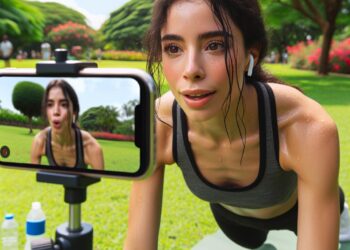Introduction
When it comes to fitness tracking, there are two camps: the people who wear their devices and the people who don’t. If you’re in the latter group, this article is for you–because we’re going to tell you why tracking your activity is so important. First off: if you don’t know where your fitness tracker has been or what it has been doing lately, then it’s not doing its job properly. Second: if you have an understanding of how these devices work and how they can help improve your life as a whole (or at least provide some entertaining moments), then let’s talk about how wearing one everyday can actually make us healthier in many ways!

Health tracking
Tracking your activity level is one of the easiest ways to get started with fitness tracking. The app will track your steps and distance travelled, as well as time spent walking or sitting at a desk, so you can see how much movement you’re getting each day.
You can also check out other measures of health like sleep patterns, hydration intake (how much water do you drink), weight loss/gain through exercise and dieting plans (the number on the scale may not be accurate), body fat percentage levels based on height/weight measurements taken by professionals who specialise in this field—and BMI which stands for Body Mass Index (BMI) is basically just a ratio between height and weight that indicates whether someone is underweight or overweight according to their body type
Activity tracking
Activity tracking is a big part of the fitness tracker experience. The activity trackers will track your steps, heart rate and even calories burned during a workout. You can use this data to see how many calories you are burning per day or week so that you can improve your fitness goals. There are many different types of activity trackers on the market today including pedometers, step counters and smartwatches with built-in sensors that measure distance travelled while wearing them on their wristband (like Fitbit).
Motivation to exercise
The challenge of staying motivated to exercise can be a major obstacle for many people. Fitness tracking devices can help you stay on track and achieve your goals.
- Motivation from others: If you have a fitness tracker, then you are able to share the results with family members or friends. This will help keep them motivated as well because they will see that their loved one is working hard at being healthier and more fit than ever before!
- Motivation from technology itself: Fitness tracking devices provide information about how much time was spent exercising each day, what types of exercises were performed during those workouts (such as running versus cycling), how long it took for those sessions to finish (even if there were breaks), what foods were consumed during these workouts…the list goes on! By providing such detailed data points on our activity levels over time without even having asked directly ourselves how we felt about our progress thus far – this means that there’s no need whatsoever anymore…
Sports performance enhancement
With the right technology, you can get a lot of value out of your workouts. Fitness tracking devices can help you track how much you’ve been working out and how long it takes to recover from each session. This helps you make informed decisions about what types of activities are most beneficial for your body type and fitness goals.
Monitor your activity level
Tracking your activity level is one of the best ways to stay on track with your fitness goals. By tracking your activity level, you can see if you’re meeting or exceeding your goals and make adjustments as necessary. For example, if you’re trying to lose weight but aren’t losing any weight even though you increase your exercise routine, increasing or decreasing what time of day you exercise may be necessary.
![]()
The benefits of fitness tracking and wearable technology
- Health tracking
- Activity tracking
- Motivation to exercise
- Sports performance enhancement
- Monitor your activity level, see what you’re doing and track your progress over time. This can help improve your fitness levels and increase confidence in yourself as well as motivation to stay active throughout the day.
Improve your performance.
The best fitness trackers are able to record your progress in a number of ways. Tracking your training sessions, recovery times and nutrition can help you understand how effective your workout is and how much damage it has caused to your body. Other useful features include tracking sleep patterns, heart rate variability (HRV), blood pressure and weight fluctuations over time.
These metrics will provide valuable insight into the state of your health so that you can make adjustments accordingly. For example: if there’s a spike in stress levels during a particularly stressful day at work, then perhaps taking some time off from training is necessary before resuming training again later on down the line; alternatively if there’s been an increase in weight loss over recent weeks then this may be down due to increased activity levels instead!
Increase your confidence.
Confidence is a key factor for success. It’s one of the most important things that you can do to feel more in control of your life and health, which will help you achieve all your goals. Fitness tracking can help give you confidence by helping keep track of how much exercise you get and how well it works for you.
This information will help show how much progress has been made over time, as well as what changes need to be made next time around (or if there are any other problems). Fitness tracking also allows users to easily see their progress through graphs or charts so they know exactly where they stand compared to others who had similar goals at different times throughout their lives
Stay motivated.
You can use fitness tracking to stay motivated. When you have a goal and deadline, it’s easier to stay on track.
- Set an overall goal: What do you want your body to look like in the future?
- Set individual goals: Do one exercise per day for three months (or whatever length of time is realistic). For example, if you want to run 10 miles each week by October 1st, start running three times per week until then!
- Set rewards along the way: Once every two weeks (or however often works best for each person), reward yourself with something fun—like going out with friends or buying yourself something new!
Track your sleep patterns and habits.
Sleep tracking can help you understand your sleep habits, quality and duration. It can also help you learn about your sleep efficiency and latency.
- Sleep efficiency is the percentage of time spent in bed that’s actually asleep. It takes into account how long it takes to fall asleep, wake up, get out of bed and go back to sleep. If you’re getting enough deep restorative REM cycles but not enough light NREM rest periods (when we’re awake), then you’ll have lower than optimal sleep efficiency rates—which means more time spent awake during the night!
- Latency refers to how long it takes for a person who is moving around during their sleep (as opposed to lying still)

Conclusion
We’re excited to see how these new technologies will benefit our everyday lives and how they can make people healthier. These devices are sure to be the next big thing in fitness tracking, so keep an eye out for them!








